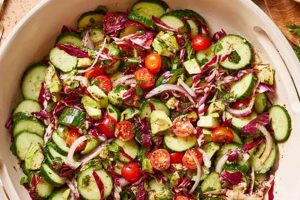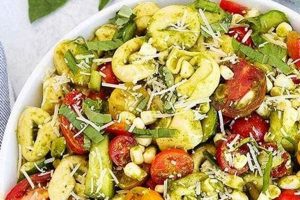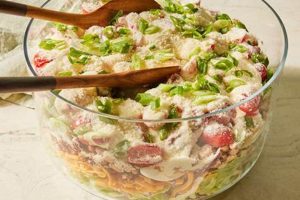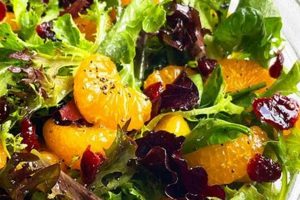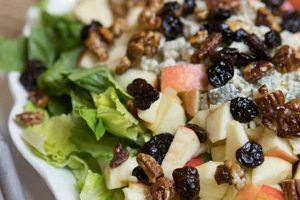Wilted spinach salads offer a delightful contrast in textures and temperatures, combining the tender, slightly softened leaves with other ingredients, often including warm dressings or protein elements like bacon, grilled chicken, or seared tofu. A simple example features baby spinach gently wilted with a warm bacon vinaigrette, crumbled bacon, and sliced hard-boiled eggs.
These salads provide a more complex flavor profile than traditional cold spinach salads. The warmth enhances the spinach’s inherent sweetness and allows it to absorb the flavors of the dressing and accompanying ingredients more readily. Furthermore, they can be enjoyed year-round, offering a comforting and satisfying meal during colder months. While fresh spinach salads have a long history, the rise in popularity of warm variations reflects contemporary culinary trends that emphasize diverse flavors and textures.
This exploration will delve into various facets of creating such salads, covering ingredient selection, dressing preparation techniques, and suggested protein pairings, along with tips for achieving optimal flavor and texture.
Tips for Creating Exceptional Warm Spinach Salads
Achieving a perfectly balanced warm spinach salad involves careful consideration of various factors. The following tips provide guidance for creating a delicious and satisfying culinary experience.
Tip 1: Select Fresh, High-Quality Spinach: Opt for vibrant, crisp spinach leaves, avoiding those with signs of wilting or discoloration. Baby spinach is ideal due to its tenderness.
Tip 2: Wilt Spinach Gently: Avoid overcooking the spinach, as this can result in a mushy texture. Lightly steaming or quickly sauting the leaves is recommended.
Tip 3: Consider Complementary Ingredients: Ingredients like mushrooms, bacon, dried cranberries, toasted nuts, or goat cheese can elevate flavor and texture profiles.
Tip 4: Prepare a Flavorful Warm Dressing: A warm vinaigrette or a simple pan sauce can significantly enhance the overall taste. Bacon grease, balsamic vinegar, and Dijon mustard are excellent foundational components for dressings.
Tip 5: Incorporate a Protein Source: Grilled chicken, salmon, or tofu can add nutritional value and a satisfying heartiness.
Tip 6: Don’t Overcrowd the Salad: Allow space between ingredients to ensure even cooking and prevent steaming.
Tip 7: Time the Assembly Carefully: Add the warm dressing and protein just before serving to maintain optimal temperature and prevent the spinach from becoming overly wilted.
By following these tips, one can create a warm spinach salad that offers a harmonious blend of flavors, textures, and temperatures. The result is a dish that is both nutritious and satisfying.
These guidelines provide a solid foundation for exploring diverse flavor combinations and customizing recipes to suit individual preferences.
1. Wilting Method
The method employed for wilting spinach significantly influences the final texture and flavor profile of a warm spinach salad. Proper wilting softens the leaves, rendering them more palatable while enhancing their inherent sweetness and allowing them to absorb dressings more effectively. Several techniques offer distinct advantages and disadvantages, each contributing a unique character to the finished dish.
- Steaming:
Steaming spinach preserves its vibrant green color and delicate flavor. A steamer basket set over simmering water gently wilts the leaves, maintaining their nutritional value. This method produces a uniformly tender texture, ideal for salads featuring lighter dressings and delicate ingredients.
- Sauting:
Sauting spinach in a hot pan with a small amount of oil or fat allows for rapid wilting and the development of subtle caramelized notes. This method imparts a richer flavor and slightly more substantial texture compared to steaming, making it suitable for salads with robust dressings and heartier components.
- Blanching:
Blanching involves briefly submerging spinach in boiling water followed by an immediate ice bath to halt the cooking process. This technique preserves the spinach’s bright color and crisp-tender texture while minimizing nutrient loss. Blanched spinach offers a refreshing contrast to other warm salad elements.
- Microwave Steaming:
Microwaving spinach with a small amount of water provides a quick and convenient wilting method. While efficient, this technique requires careful attention to prevent overcooking, which can result in a mushy texture. It is best suited for simple preparations where speed is a priority.
The chosen wilting method should complement the overall composition of the warm spinach salad. Considerations include the desired texture, the intensity of the dressing, and the other ingredients incorporated. Selecting the appropriate technique enhances the balance of flavors and textures, ensuring a more enjoyable culinary experience.
2. Dressing Choice
The selection of a dressing is paramount in shaping the flavor profile of a warm spinach salad. The dressing not only complements the spinach but also harmonizes with other ingredients, creating a cohesive and balanced culinary experience. A well-chosen dressing enhances the inherent flavors of the spinach and other components while adding depth and complexity.
- Warm Vinaigrettes:
Warm vinaigrettes offer a classic approach, providing a balance of acidity and richness. A simple warm bacon vinaigrette, for example, combines the rendered fat from bacon with vinegar, creating a smoky and tangy dressing that complements the earthy spinach. Variations can include balsamic vinegar for a sweeter profile or red wine vinegar for a sharper tang. The warmth of the vinaigrette further wilts the spinach and enhances its ability to absorb the dressing’s flavors.
- Creamy Dressings:
Warm creamy dressings offer a decadent counterpoint to the spinach. A warm goat cheese dressing, for instance, provides a tangy and savory element that pairs well with roasted vegetables and nuts. Alternatively, a warm blue cheese dressing offers a pungent and salty contrast, complementing ingredients like bacon or steak. The creamy texture adds richness and coats the spinach, creating a more substantial salad.
- Simple Pan Sauces:
Utilizing pan sauces offers an efficient and flavorful approach. The residual flavors and fond from cooking proteins, such as chicken or mushrooms, form the base of the dressing. Deglazing the pan with wine or stock creates a rich and savory sauce that coats the spinach and other ingredients, unifying the flavors of the salad. This method minimizes additional preparation steps and maximizes flavor development.
- Asian-Inspired Dressings:
Warm Asian-inspired dressings offer a unique and vibrant flavor profile. A sesame-ginger dressing, for example, provides a nutty and slightly spicy element that complements ingredients like edamame, mandarin oranges, and grilled tofu. Alternatively, a peanut dressing adds a creamy and savory dimension, pairing well with shredded carrots and chopped peanuts. These dressings often incorporate soy sauce, rice vinegar, and sesame oil, creating a complex and balanced flavor profile.
The interplay between the chosen dressing and other ingredients in a warm spinach salad is crucial for achieving a harmonious and satisfying dish. The dressing acts as a unifying element, tying together the various flavors and textures. Careful consideration of the dressing’s flavor profile, its temperature, and its compatibility with other components ensures a well-balanced and enjoyable culinary experience.
3. Protein Selection
Protein selection significantly impacts the overall composition and nutritional value of warm spinach salads. The chosen protein contributes not only to the salad’s heartiness and satiety but also influences its flavor profile and textural complexity. Careful consideration of protein pairings allows for a balanced and satisfying meal.
Grilled chicken breast, a lean protein source, provides a neutral backdrop that allows other flavors to shine. Its slightly charred exterior adds a textural element, contrasting with the tender spinach. Alternatively, incorporating seared salmon introduces richness and omega-3 fatty acids. The flaky texture of the salmon complements the spinach, while its robust flavor pairs well with lighter vinaigrettes. Crispy bacon bits offer a salty, smoky element and textural contrast, enhancing the overall sensory experience. For vegetarian options, pan-fried tofu, marinated and seasoned appropriately, delivers a satisfying protein source with a versatile flavor profile that absorbs the dressing effectively. Other plant-based alternatives include lentils, chickpeas, or hard-boiled eggs, each offering unique nutritional benefits and textural nuances.
The interplay between the chosen protein and the other salad components is crucial. A robust protein like steak may overwhelm a delicate vinaigrette, while a lighter protein like shrimp might be lost against a strong, creamy dressing. Understanding these nuances facilitates the creation of a harmonious balance of flavors and textures. Furthermore, considering the protein’s preparation method, whether grilled, seared, or roasted, contributes additional layers of flavor and texture. Strategic protein selection elevates warm spinach salads from a simple side dish to a complete and satisfying meal, offering diverse options to suit individual dietary preferences and taste profiles.
4. Complementary Ingredients
Complementary ingredients play a crucial role in elevating warm spinach salads from simple to sophisticated. These additions contribute textural contrasts, enhance flavor profiles, and introduce visual appeal, transforming the dish into a multi-sensory experience. Strategic selection of complementary ingredients ensures a balanced and harmonious final product.
- Fruits and Dried Fruits:
Fruits offer a contrasting sweetness and a burst of freshness. Sweet and tart dried cranberries provide a chewy texture and pair well with creamy dressings and nuts. Fresh berries, such as strawberries or blueberries, introduce a juicy element and vibrant color. Mandarin orange segments offer a citrusy tang that complements Asian-inspired dressings. The choice of fruit depends on the overall flavor profile desired.
- Nuts and Seeds:
Nuts and seeds provide a satisfying crunch and contribute healthy fats. Toasted pecans or walnuts offer a rich, buttery flavor, while slivered almonds provide a delicate crunch. Sunflower or pumpkin seeds introduce a nutty element and boost nutritional value. Toasted nuts enhance their flavor and create a more pronounced textural contrast against the soft spinach.
- Cheese:
Cheese introduces a creamy or crumbly texture and a savory element. Crumbled goat cheese offers a tangy flavor that pairs well with balsamic vinaigrettes. Blue cheese provides a pungent and salty contrast. Feta cheese adds a salty, briny element, particularly suitable for Mediterranean-inspired salads. Shaved Parmesan offers a nutty and umami flavor. The choice of cheese should complement the other ingredients and the dressing.
- Vegetables:
Roasted or sauted vegetables introduce additional layers of flavor and texture. Roasted root vegetables, such as sweet potatoes or beets, offer a caramelized sweetness. Sauted mushrooms provide an earthy element. Red onions offer a sharp bite, while bell peppers contribute sweetness and crunch. The choice of vegetables can complement the protein and the overall flavor profile of the salad.
The interplay of these complementary ingredients with the spinach, dressing, and protein defines the character of the warm spinach salad. Careful consideration of flavor combinations, textural contrasts, and color palettes elevates the dish from a simple combination of ingredients to a well-composed and satisfying culinary creation. A balance of flavors and textures ensures an enjoyable and memorable dining experience.
5. Temperature Balance
Temperature balance is crucial in warm spinach salads, impacting both flavor perception and textural enjoyment. The defining characteristic of these salads lies in the interplay between the warm elements, primarily the dressing and often a protein component, and the fresh spinach. If the warm elements are too hot, they can overcook the spinach, resulting in a wilted, unappetizing texture and a muted flavor profile. Conversely, if the warm components are not sufficiently heated, the spinach may not wilt properly, leading to a less harmonious blend of textures and a potential lack of flavor integration. For example, a warm bacon vinaigrette needs to be at the ideal temperature to lightly wilt the spinach without making it soggy, while simultaneously allowing the bacon flavor to infuse the leaves. Similarly, adding grilled chicken that is too hot can overcook the surrounding spinach, whereas chicken that is not warm enough might result in a less appealing salad experience. Achieving the optimal balance ensures the spinach softens just enough to enhance its flavor and create a pleasant textural contrast with the other ingredients.
This balance extends beyond the spinach itself. Consider a salad with goat cheese and toasted walnuts. If the goat cheese melts completely due to excessive heat from the other elements, it loses its distinctive tangy flavor and creamy texture, becoming homogenous and less appealing. Similarly, if the walnuts are added while still hot from toasting, they can lose their crispness and become oily upon contact with the other ingredients. Maintaining appropriate temperatures for each element ensures they retain their distinct characteristics, contributing to the overall complexity and balance of the salad. A successful warm spinach salad relies on a careful orchestration of temperatures, preventing any single element from dominating the others and ensuring a harmonious blend of flavors and textures.
Mastering temperature balance in warm spinach salads elevates the dish from a simple combination of ingredients to a carefully constructed culinary experience. This understanding allows for greater control over the final product, ensuring that each element contributes its optimal flavor and texture. Awareness of temperature interactions also facilitates adaptability in recipe execution. For instance, if a protein is hotter than anticipated, it can be allowed to cool slightly before being added to the salad, preventing over-wilting of the spinach. This flexibility empowers culinary creativity while ensuring consistent and enjoyable results. By recognizing temperature as a key variable, one can achieve optimal flavor development and textural harmony in warm spinach salads, transforming them into a delightful and satisfying dish.
6. Freshness of Spinach
Freshness plays a pivotal role in the success of warm spinach salads. Spinach, when fresh, possesses a vibrant green hue, a crisp texture, and a slightly sweet, earthy flavor. These qualities are essential for achieving the desired balance in a warm spinach salad. Fresh spinach wilts evenly when exposed to heat, maintaining a pleasant texture and readily absorbing the flavors of the warm dressing. In contrast, stale spinach may have a dull color, a slimy texture, and a bitter or off-flavor. When heated, it tends to become excessively wilted, resulting in an unappetizing, mushy consistency. Furthermore, stale spinach may not absorb the dressing effectively, leading to a less flavorful and enjoyable salad. For example, a warm spinach salad with bacon vinaigrette relies on the fresh spinach’s ability to absorb the smoky, salty flavors of the dressing. Stale spinach, however, would compromise this flavor integration.
Beyond flavor and texture, the freshness of spinach also influences the visual appeal of the salad. Fresh spinach provides a vibrant backdrop that enhances the colors of other ingredients, such as bright red berries or golden-brown roasted vegetables. Stale spinach, with its dull appearance, detracts from the overall presentation. Consider a warm spinach salad featuring grilled salmon and goat cheese. Fresh spinach creates a visually appealing contrast with the pink salmon and white cheese, while stale spinach would diminish the vibrancy of these colors. Moreover, fresh spinach contributes to the nutritional value of the salad, providing essential vitamins and minerals. Stale spinach, having degraded over time, offers diminished nutritional benefits. Therefore, selecting fresh spinach is crucial for maximizing both the culinary and nutritional value of warm spinach salads.
Prioritizing spinach freshness ensures optimal flavor, texture, and visual appeal in warm spinach salads. This understanding facilitates informed ingredient selection and enhances the likelihood of creating a successful and satisfying culinary experience. Recognizing the impact of spinach freshness on the final product allows for adjustments in recipe execution. If only slightly wilted spinach is available, it might be incorporated into a salad with a lighter vinaigrette to avoid further wilting, whereas exceptionally fresh spinach can withstand a richer, warmer dressing. This adaptability ensures consistent and enjoyable results regardless of variations in spinach freshness. Ultimately, recognizing the significance of fresh spinach is paramount for achieving the desired balance of flavors, textures, and visual appeal that defines a truly exceptional warm spinach salad.
Frequently Asked Questions
This section addresses common inquiries regarding warm spinach salads, providing clear and concise information to ensure successful preparation and enjoyable culinary experiences.
Question 1: How can one prevent the spinach from becoming overly wilted or soggy?
Over-wilting can be avoided by using the appropriate wilting method and ensuring the dressing is not excessively hot. Adding the warm dressing just before serving also helps maintain the spinach’s texture.
Question 2: What are suitable alternatives to bacon for a warm spinach salad?
Alternatives to bacon include pan-fried pancetta, prosciutto crisps, or, for vegetarian options, roasted nuts or sunflower seeds, which offer similar salty and crunchy elements.
Question 3: Can other greens be substituted for spinach in these recipes?
While spinach is ideal due to its tenderness, other greens like baby kale or arugula can be substituted, though they may require adjustments in cooking time and dressing selection.
Question 4: How long can a warm spinach salad be stored in the refrigerator?
Storing warm spinach salad is not recommended as the spinach will continue to wilt and the other ingredients may lose their desired textures. It is best consumed immediately after preparation.
Question 5: What are some strategies for balancing the flavors in a warm spinach salad?
Flavor balance is achieved by considering the interplay of sweet, sour, salty, and savory elements. For instance, a sweet dressing might be balanced by a salty protein like bacon, while a tangy vinaigrette complements earthy mushrooms.
Question 6: Are warm spinach salads suitable for meal prepping?
While components like the protein and dressing can be prepared in advance, assembling the salad just before serving is recommended to maintain the spinach’s texture and the overall temperature balance.
Understanding these frequently asked questions assists in addressing potential challenges and optimizing preparation techniques, maximizing the likelihood of creating delicious and satisfying warm spinach salads.
For further culinary exploration, the following sections will provide specific recipe examples and variations, allowing practical application of these principles.
Warm Spinach Salad Recipes
Warm spinach salad recipes offer a versatile and adaptable culinary canvas. Exploration of key elementswilting methods, dressing choices, protein selections, complementary ingredients, temperature balance, and spinach freshnessreveals the nuanced interplay contributing to a successful dish. Understanding these components empowers informed decision-making, allowing for customization and creative expression within this culinary framework. From the simplicity of a warm bacon vinaigrette to the complexity of an Asian-inspired creation with sesame-ginger dressing, the possibilities are vast.
The continued evolution of warm spinach salad recipes promises exciting culinary innovation. As culinary preferences shift and new ingredients emerge, exploration of flavor profiles and textural combinations will undoubtedly yield further delightful and satisfying renditions. Culinary enthusiasts are encouraged to embrace experimentation, adapting these fundamental principles to create personalized expressions of this versatile dish. The potential for crafting unique and delicious warm spinach salads remains boundless.

